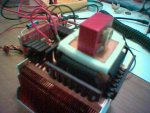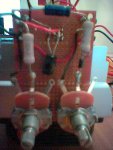I, personally - and others may disagree with this, but... would not bother to run a regulator on the TEC circuit IF: 1. I was running from batteries that were less than 90% of the Vmax of the device and 2. I was planning to run the device at currents at 50% or less of the Imax of the device.
So from my perspective, the answer is that yes, a resistor should be fine if you're operating from 7.2 volts on a device made to run up to 15vdc. These things don't care if the voltage or current is STABLE, only that it doesn't exceed the device's maximums. And as I think you noted earlier - you don't want this thing to cool enough to cause frost or even condensation, so you're not going to be operating anywhere near your maximums.
As for suggesting a value - you're probably going to want to start by pumping about 1/4 it's max I into it. You'll want a pot that can take an amp or two at your voltage to avoid burning the pot. Just say no to burning pot...

I'd just manually tweak the pot until I got the cooling response that was sufficient for the diode's operational characteristics, ie., make it so the diode feels slightly cooler than room temp when running at a higher-than-normal duty cycle.
Sound good?
These devices are fun to play with - they respond immediately and are very easy to just try things out on to get them set up. It'll probably take you less time to work your resistor values in than it did to read this post!
One last note - if you're operating your diode and TEC from the same batteries, it should work out well in that if your TEC battery is going dead, and you're losing cooling ability - your diode should be ready to go to sleep as well!

If, however, you're running separate batteries for LD & TEC, you may want to be sure the TEC battery never dies before the LD battery does...
D





